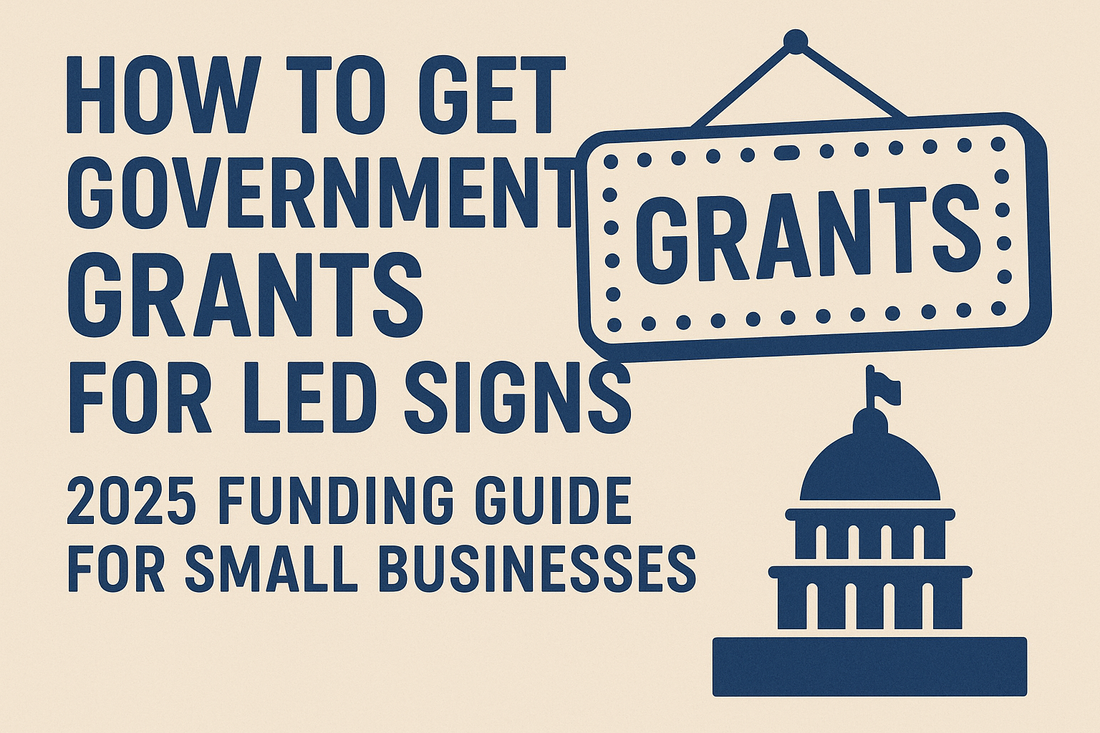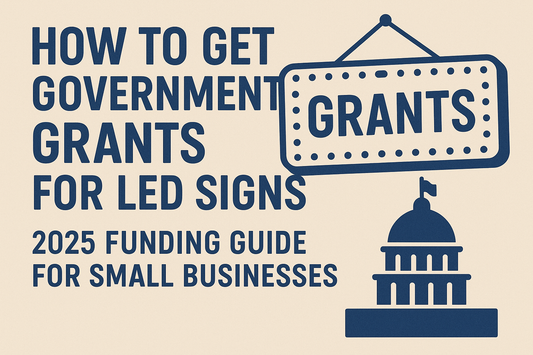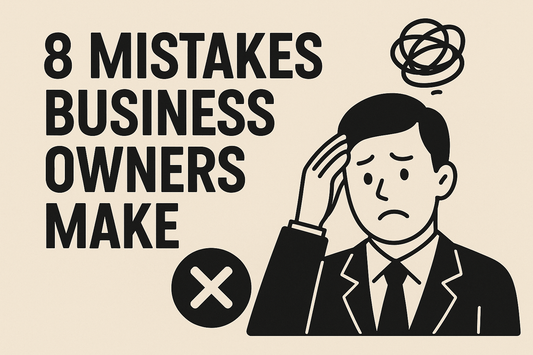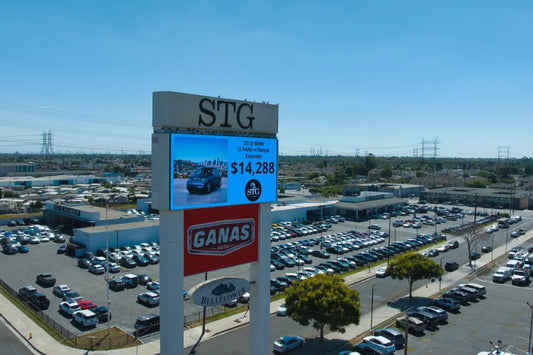
How to Get Government Grants for LED Signs: 2025 Funding Guide for Small Businesses
Want to upgrade your business with an eye-catching LED sign but worried about the cost? You're not alone. Many small business owners don't realize that multiple government funding opportunities exist to help offset the expense of LED signage—from direct grants to tax deductions worth thousands of dollars.
In this comprehensive guide, we'll walk you through every funding option available in 2025, including federal grants, state programs, utility rebates, and powerful tax strategies that can dramatically reduce your out-of-pocket costs for a new LED sign.
Understanding LED Sign Funding: What's Available in 2025
While there's no single "LED sign grant" program from the federal government, businesses can access funding through several strategic pathways. LED signs qualify as energy-efficient equipment, depreciable business assets, and infrastructure investments—making them eligible for various funding mechanisms.
The three main funding categories for LED signs include:
Energy Efficiency Incentives: Since LED technology significantly reduces energy consumption compared to traditional signage, multiple utility companies and government programs offer rebates and grants for LED upgrades. These programs recognize that LED signs can reduce lighting-related energy consumption by up to 80%.
Small Business Equipment Grants: Federal and state programs that provide funding for business equipment purchases often include LED signs as qualifying assets, particularly when they support job creation or economic development.
Tax Deductions and Credits: The Section 179 tax deduction allows businesses to immediately write off the full cost of LED sign purchases, offering substantial tax savings that effectively lower the investment cost.
Section 179 Tax Deduction: The Fastest Way to Save on LED Signs
The Section 179 tax deduction represents one of the most powerful financing tools for businesses purchasing LED signs in 2025. Unlike traditional depreciation that spreads deductions over several years, Section 179 allows you to deduct the entire purchase price in the year you buy and install your sign.
2025 Section 179 Limits:
Maximum deduction: $1,250,000
Spending cap before phase-out: $3,130,000
Qualifying assets: New and used equipment, including LED signs
How It Works: If your business purchases a $50,000 LED sign and you're in the 25% tax bracket, you could save $12,500 in federal taxes. This effectively reduces your sign's cost to $37,500. LED signs qualify as tangible personal property under Section 179, making them immediately eligible for this deduction.
To claim Section 179, your LED sign must be purchased or financed and placed into service before December 31, 2025. Whether you buy, finance, or lease your LED sign, you can take advantage of this deduction. Simply complete IRS Form 4562 and attach it to your tax return.
Bonus Depreciation in 2025: After maximizing Section 179, businesses can also claim bonus depreciation at 40% for the 2025 tax year on qualifying LED sign purchases. This provides an additional layer of tax savings for larger investments.
Energy Efficiency Grants and Rebates for LED Signs
LED signs are inherently energy-efficient, making them eligible for numerous utility and government energy programs. These incentives are designed to encourage businesses to adopt technologies that reduce electricity consumption and support sustainability goals.
Federal Energy Programs
Energy Efficiency and Conservation Block Grants (EECBG): This federal program offers substantial funding for energy-efficient upgrades, including LED lighting and signage. With nearly $6 billion in infrastructure funding managed through the Office of State and Community Energy Programs, these grants support businesses transitioning to sustainable technologies.
The program provides funding for commercial energy audits, LED upgrades, and energy-efficient retrofits. To access funding, businesses typically apply through their state or local government, which administers the federal grant allocation.
Department of Energy (DOE) Funding Opportunities: The DOE regularly announces competitive funding opportunities for energy-efficient technology adoption. While these grants often focus on research and development, businesses implementing innovative LED solutions may qualify for funding consideration.
State and Utility Company Rebates
Approximately 77% of the United States is covered by active commercial lighting rebate programs. These state-specific and utility-sponsored initiatives offer direct cash rebates for LED installations, including exterior signage.
Top states for LED rebates include:
California, New York, Illinois, and Texas offer some of the most extensive rebate opportunities. Many utility companies provide rebates ranging from $50 to several thousand dollars depending on the project size and energy savings achieved.
To find rebates in your area, use the Database of State Incentives for Renewables and Efficiency (DSIRE), which provides a comprehensive state-by-state breakdown of available incentives. You can also contact your local utility provider directly to inquire about commercial LED signage rebate programs.
Application Process: Most rebate programs require pre-approval before purchasing equipment. Submit your application with technical specifications, and upon approval, proceed with installation by certified professionals. After installation, submit completion documentation including invoices and proof of installation to receive your rebate funds.
Small Business Grants That Cover LED Sign Purchases
While few grants specifically target LED signage, numerous small business equipment grants accept LED signs as qualifying purchases. Here are the most accessible options for 2025:
USDA Rural Business Development Grants
If your business operates in a rural area (outside the urbanized periphery of cities with populations over 50,000), you may qualify for USDA Rural Business Development Grants. These grants support small and emerging businesses with fewer than 50 employees and less than $1 million in gross revenue.
Grant amounts: Typically $10,000 to $500,000
Eligible uses: Equipment purchases, facility improvements, and business expansion
Application: Through your local USDA Rural Development office
LED signs qualify when they support business development, job creation, or economic growth in rural communities. Applications are evaluated based on job creation potential, economic need, and alignment with local economic development priorities.
Economic Development Administration (EDA) Grants
The EDA provides grants to communities and businesses that promote economic development and job creation. While EDA grants primarily target infrastructure and larger economic development projects, LED signage can qualify when it's part of a broader business expansion or community revitalization initiative.
Program types:
Public Works grants for infrastructure that supports economic development
Economic Adjustment Assistance for businesses responding to economic changes
Planning and Technical Assistance for strategy development
Contact your regional EDA office to discuss how LED signage might fit within their current funding priorities and your community's economic development strategy.
State-Level Small Business Grants
Many states offer equipment grants specifically for small businesses. Pennsylvania's Small Business Advantage Grant, for example, provides reimbursement grants of 50% to 80% for energy-efficient equipment purchases, with maximum awards ranging from $7,500 to $12,000.
Check with your state's economic development office, small business development center, or department of environmental protection for similar programs in your area.
Private and Corporate Grant Opportunities
Beyond government programs, numerous private organizations and corporations offer small business grants that can fund LED sign purchases:
NASE Growth Grants: The National Association for the Self-Employed awards up to $4,000 quarterly for business needs including marketing and equipment. Applications are reviewed in January, April, July, and October.
FedEx Small Business Grant: Annual competition awarding grants up to $50,000 for small businesses, with LED signage qualifying as eligible business equipment.
Skip Growth Grant: Monthly $1,000 instant grants and larger $10,000 grants available to U.S.-based business owners throughout the year.
Freed Fellowship Grant: $500 monthly micro-grants for small business owners, with potential for larger end-of-year awards.
Alternative Financing Options for LED Signs
If grants aren't immediately available, several financing strategies can make LED signs more affordable:
SBA 7(a) Loans
The Small Business Administration's 7(a) loan program guarantees loans from commercial lenders for various business purposes, including equipment purchases like LED signs. While this is a loan rather than a grant, the SBA guarantee makes it easier for small businesses to qualify for favorable terms.
Equipment Financing
Many LED sign manufacturers, including Best LED Signs, offer financing options that spread the cost over manageable monthly payments. Combined with Section 179 tax benefits, this approach provides immediate signage benefits while maximizing tax advantages.
Step-by-Step Guide to Securing LED Sign Funding
Step 1: Calculate Your Total Investment
Determine the size, type, and features you need for your LED sign. Get detailed quotes from reputable suppliers to establish your budget.
Step 2: Research Local Opportunities First
Contact your utility company and local economic development office to identify available rebates and grants in your specific area. These local programs often have less competition than federal grants.
Step 3: Check Section 179 Eligibility
Consult with your tax advisor to calculate potential Section 179 savings based on your business's taxable income. This immediate tax benefit should be part of every LED sign investment strategy.
Step 4: Apply for Pre-Approval
Many rebate and grant programs require pre-approval before purchase. Submit applications early with all required documentation to secure funding commitments.
Step 5: Document Everything
Keep detailed records of all applications, approvals, invoices, and installation documentation. Proper documentation is essential for claiming rebates, grants, and tax deductions.
Step 6: Install and Verify
Work with certified professionals to install your LED sign according to program requirements. Many rebate programs require certified installation to qualify for funding.
Step 7: Submit Claims and File Taxes
Follow through on all rebate claim submissions and work with your tax preparer to properly claim Section 179 deductions on your tax return.
Maximizing Your ROI: Combining Multiple Funding Sources
The most cost-effective approach combines multiple funding sources to minimize your out-of-pocket investment. Here's a real-world example:
Example Scenario:
LED Sign Cost: $40,000
Utility Rebate: -$3,000
Section 179 Tax Savings (25% bracket): -$9,250
Effective Net Cost: $27,750
By stacking a utility rebate with Section 179 tax benefits, this business reduced their LED sign investment by more than 30%. Factor in the energy savings from reduced electricity consumption (often 50-80% compared to traditional signage), and the sign typically pays for itself within 2-4 years.
Common Mistakes to Avoid When Seeking LED Sign Funding
Not Getting Pre-Approval: Many rebate programs require approval before purchase. Buying your LED sign first may disqualify you from available funding.
Missing Documentation: Incomplete applications or missing paperwork can delay funding or result in denial. Create a checklist and track all required documents.
Ignoring Deadlines: Grant programs and rebates often have specific application windows. Mark important deadlines and submit applications early.
Forgetting to Consult a Tax Professional: Section 179 rules can be complex. Work with a qualified tax advisor to ensure you're maximizing benefits and meeting all IRS requirements.
Overlooking Local Programs: While federal programs get more attention, state and local initiatives often provide faster approval and less competition.
How LED Signs Support Broader Business Goals
When applying for grants or presenting your case to lenders, emphasize how LED signage supports larger business objectives:
Job Creation: Many grant programs prioritize projects that create employment. If your LED sign is part of a business expansion that will add jobs, highlight this connection in your applications.
Energy Efficiency: LED signs reduce energy consumption by 50-80% compared to traditional illuminated signs. This sustainability angle aligns with many grant program priorities.
Economic Development: LED signage can revitalize storefronts and attract customers, contributing to broader community economic development—a key consideration for EDA and USDA grants.
Competitive Positioning: A professional LED sign enhances your business's visibility and credibility, supporting growth and competitiveness in your market.
Expert Tips for Grant Application Success
Tell a Compelling Story: Don't just list facts. Explain how the LED sign will transform your business, create jobs, or benefit your community.
Provide Data: Include projected energy savings, customer traffic increases, and other quantifiable benefits. Grant reviewers favor applications with concrete metrics.
Show Matching Funds: Many grants require cost-sharing. Demonstrating you have other funding sources (like Section 179 tax benefits) shows commitment and financial stability.
Connect to Program Goals: Align your application language with the grant program's stated priorities. If they emphasize sustainability, highlight energy efficiency. If they focus on job creation, emphasize employment impacts.
Follow Up: After submitting applications, maintain communication with program administrators. Ask about timelines and whether any additional information is needed.
Resources and Tools for Finding LED Sign Funding
Grants.gov: The federal government's comprehensive database of grant opportunities. Search by keyword for equipment grants that might include LED signage.
DSIRE (Database of State Incentives for Renewables & Efficiency): State-by-state breakdown of energy efficiency rebates and incentives, including LED lighting programs.
Your Local Utility Company: Contact their commercial programs department directly to learn about LED rebates and application processes.
Small Business Development Centers (SBDCs): Free consulting services that can help identify grant opportunities and prepare applications.
Section 179 Calculator: Online tools at Section179.org help estimate potential tax savings from LED sign purchases.
Your State Economic Development Office: Information on state-specific grants and business assistance programs.
The Future of LED Sign Funding
As energy efficiency becomes increasingly prioritized in federal and state policy, funding opportunities for LED technology continue to expand. The Infrastructure Investment and Jobs Act has allocated billions for energy efficiency improvements, with more programs launching throughout 2025.
Additionally, as bonus depreciation phases down through 2027, Section 179 becomes even more valuable for businesses seeking immediate tax benefits from equipment purchases. The permanent status of Section 179 makes it a reliable planning tool for LED sign investments.
Don't let upfront costs prevent you from investing in a powerful marketing tool for your business. With strategic use of grants, rebates, and tax deductions, LED signs become significantly more affordable—and the long-term energy savings and increased customer visibility make them one of the smartest investments a small business can make.
Ready to explore your options? Contact the experts at Best LED Signs to discuss your signage needs and learn how to maximize available funding opportunities for your business.
Frequently Asked Questions
Yes, LED signs qualify as tangible personal property under Section 179, allowing businesses to deduct the full purchase price up to $1,250,000 in 2025. This applies to both new and used LED signs purchased or financed and placed into service before December 31, 2025.
While no federal program exclusively funds LED signs, multiple grant opportunities include LED signage as eligible equipment. Energy efficiency grants, small business equipment grants, and rural business development grants can all potentially fund LED sign purchases when they align with program goals.
Utility rebates vary by location and program, typically ranging from $50 to several thousand dollars depending on your project size and energy savings. Approximately 77% of U.S. businesses have access to commercial LED lighting rebate programs through their local utility providers.
Yes, you can typically stack Section 179 tax deductions with utility rebates and other grant funding. However, consult your tax advisor as some grant programs may reduce the depreciable basis for tax purposes if they provide direct financial assistance.
Most utility rebate programs and many grant programs require pre-approval before purchasing equipment. Buying your LED sign before approval may disqualify you from receiving funding. Always apply and receive approval confirmation before making your purchase.
Typical documentation includes business tax returns, detailed project proposals, equipment specifications, cost estimates or quotes, energy savings calculations, and proof of business eligibility. Grant applications may also require business plans, financial projections, and job creation estimates.
Timeline varies by program. Utility rebates typically process within 8-12 weeks after installation verification. Federal grants may take 1-3 months or longer. Section 179 tax benefits are realized when filing your annual tax return. Plan accordingly and maintain detailed records throughout the process.
Yes, if your business operates in an eligible rural area and meets size requirements (fewer than 50 employees and less than $1 million in gross revenue), LED signs can qualify under USDA Rural Business Development Grants when they support business development and job creation goals.





